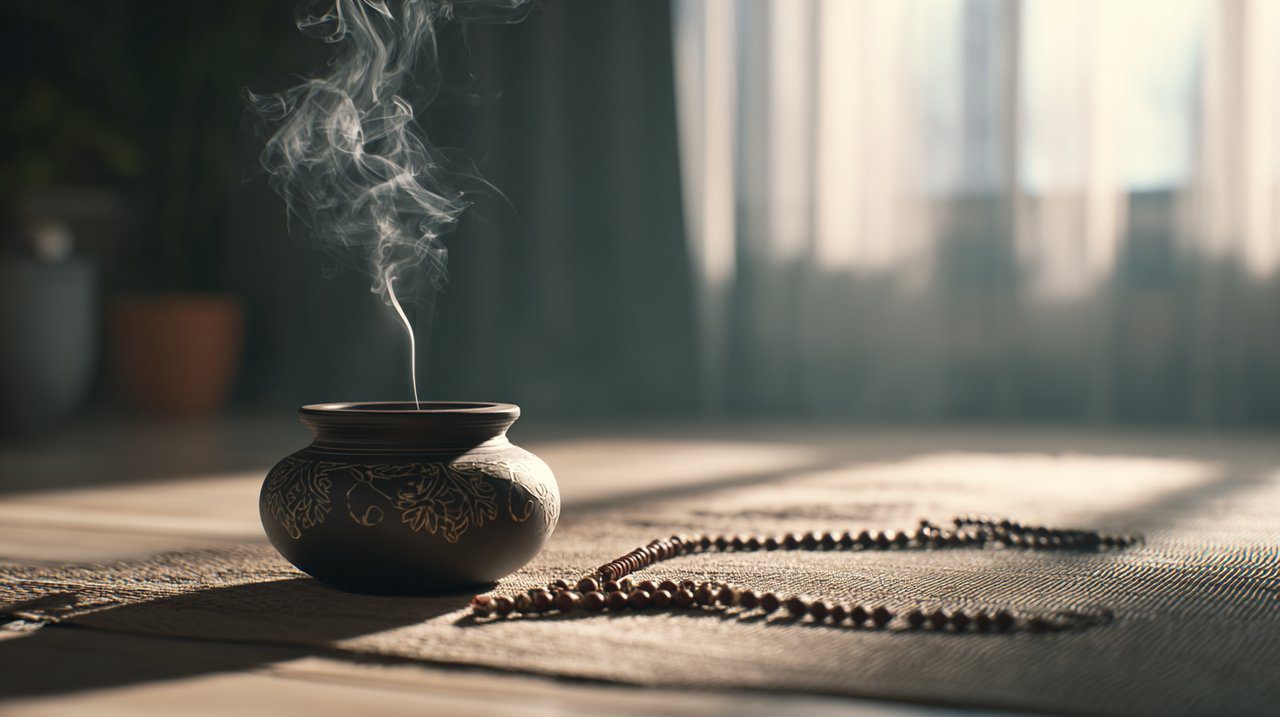How to Choose a Tibetan Incense Holder: Elevate Your Space with Authentic Design & Meaning
Finding tranquility in our daily lives often begins with the simplest gestures, transforming ordinary moments into spaces of mindful presence. The objects we invite into our homes can serve as gentle anchors for this journey.
Choosing a Tibetan incense holder is not merely about selecting a decorative item; it is an invitation to embark on a subtle, yet profound, journey. We move from the tangible beauty of design and material to the intangible depth of intention and personal resonance.
This guide will illuminate the path, offering distinct, actionable insights. Each step is a micro-guide, designed to help you find a holder that truly elevates your space and deepens your Mindfulness practices.
Material & Craftsmanship: Feeling the Earth's Connection
The foundation of any meaningful object lies in its substance. When considering a Tibetan incense holder, begin by connecting with the materials themselves.
These holders are often crafted from natural elements, each carrying a unique energy and story. Imagine the comforting weight of a brass holder in your palm, or the smooth coolness of a stone piece. The choice of material speaks to a desire for grounding and an appreciation for the earth's gifts.
Authentic pieces are typically handmade, bearing the subtle imperfections that tell a tale of human touch and dedication. This artistry makes each one truly unique.
- Copper or Brass: These materials are known for their durability and warm, inviting luster. They often develop a beautiful patina over time, reflecting the passage of your own mindful moments.
- Stone (e.g., soapstone, marble): Offers a cool, stable presence, grounding the energy of your space.
- Wood: Brings organic warmth and a deep connection to nature, often intricately carved with intricate details.
We encourage you to avoid mass-produced items that lack this inherent connection to craft. A truly resonant holder will feel substantial and unique, a testament to its origins and the hands that shaped it.
Symbolism & Iconography: Let Meaning Flow in Your Space
Many Tibetan incense holder designs incorporate sacred symbols and traditional iconography. These are not mere decorations; they are visual prayers, encapsulating ancient wisdom and intentions.
Understanding their meaning allows your holder to become a silent teacher and a source of inspiration for your practice. For instance, the Endless Knot (Shrivatsa) symbolizes the interconnectedness of all things and the infinite cycle of wisdom and compassion.
Placing such a symbol in your meditation space can subtly remind you of these profound truths during Tibetan meditation. Another common motif is the Eight Auspicious Symbols (Ashtamangala), which collectively represent the offerings made to the Buddha upon his enlightenment.
Each symbol, such as the Lotus (purity) or the Dharma Wheel (the path to liberation), can imbue your holder with specific qualities. We invite you to choose symbols that genuinely resonate with your personal journey or intentions. A brief exploration of their origins can transform your holder from an object of beauty into a profound spiritual anchor.
Functionality & Form: The Harmonious Beauty of Practice
While beauty and meaning are crucial, the practical aspect of your Tibetan incense holder ensures a smooth and uninterrupted ritual. To truly enhance your daily Mindfulness practices, we encourage you to prioritize its functionality.
Consider how the holder will manage ash from your Tibetan incense sticks. Some designs feature a broad, flat base to catch all residue, ensuring a clean space. Others might be enclosed, containing the ash neatly within.
An open design can allow the scent to disperse more freely, inviting the aroma to fill your space. Meanwhile, an enclosed one might offer a more contained, focused burn, perfect for a concentrated practice.
- Ash Collection: Does it effectively catch all ash, preventing any mess and maintaining the sanctity of your space?
- Stability: Is it sturdy and balanced, especially if it will be used in an active space or near a gentle breeze?
- Incense Type: Is it thoughtfully designed for Tibetan incense sticks (which often have no core) or other forms like cones or coils?
An incense holder should be a silent partner, seamlessly supporting your ritual without distraction. The harmony between its form and its purpose contributes directly to the tranquility of your space, much like well-chosen Zen decor.
The Intentional Chalice: A Tibetan Incense Holder's Deeper Meaning
Beyond its material and form, a Tibetan incense holder can serve a far deeper purpose. It is not merely a receptacle for ash; it is an Intentional Chalice, a sacred vessel that actively participates in your micro-rituals.
It becomes an energy convergence point for your focus, meditation, and aspirations. When you light Sandalwood incense in your holder, you are not just burning an aromatic stick. You are activating an intention, a prayer, a moment of deep presence.
The holder, in its stillness, becomes a physical anchor for this unseen energy, holding and amplifying your heartfelt desires.
"Objects, when imbued with intention, cease to be mere things and become extensions of our spirit."
Consider how a simple gesture, like placing your Mala beads beside it, or bringing your awareness to the rising smoke, can transform the holder into a focal point. It becomes a silent witness, a constant reminder of the sacred space you cultivate within and around you.

Personal Resonance: Listening to Your Inner Guide
Ultimately, the most authentic choice for a Tibetan incense holder stems from your personal connection and intuition. No amount of external advice can replace the quiet wisdom of your inner guide.
As you explore different designs, take a moment to pause. Hold the object, if possible, or gaze at its image. Does it evoke a sense of peace, inspiration, or groundedness within you? Does it feel like an extension of your intention for creating a mindful space?
Allow your heart to speak. The holder you choose should feel like a natural fit for your unique spiritual landscape, a visual and tactile representation of your desire for tranquility and focus. It's about finding a piece that feels like it truly belongs in your personal sanctuary, reflecting your inner world.
Scented Symphony: The Art of Pairing with Tibetan Incense Sticks
The Tibetan incense holder finds its full expression when paired with the right Tibetan incense sticks. This pairing is an art, creating a scented symphony that elevates your entire ritual.
Tibetan incense is unique, often made from a blend of herbs, spices, and flowers, without a bamboo core. This results in a purer, more natural aroma that can truly enhance your practice. The holder you choose should complement these unique characteristics, both aesthetically and functionally.
For example, a robust, earthy Tibetan incense holder made of stone might beautifully complement the deep, grounding notes of Sandalwood incense or cedar. Conversely, a more delicate, intricately carved metal holder might highlight the subtle, complex aromas of floral or spiced incense blends.
We invite you to experiment with different scents and holders. Notice how the visual presence of the holder interacts with the aromatic journey of the incense. This conscious pairing deepens the sensory experience, further enriching your Mindfulness practices.
Cultivating Your Sacred Space
Choosing a Tibetan incense holder is a conscious act, a gentle step towards cultivating a space imbued with peace and intention. It is a journey from the tangible to the profound, allowing an everyday object to become a powerful tool for inner stillness.
By considering its material, symbolism, function, and most importantly, how it resonates as an Intentional Chalice, you select more than just an item. You welcome a companion into your mindful practice, ready to hold your intentions and elevate your daily rituals.
Take this opportunity to allow your selection to be a reflection of your commitment to a life of presence and reverence. Remember, the true wisdom lies in transforming the ordinary into the extraordinary, one mindful breath at a time.
💡 Frequently Asked Questions
Authentic Tibetan incense holders are often crafted from natural materials such as copper, brass, stone (like soapstone or marble), and wood. Copper and brass offer durability and a warm luster that develops a beautiful patina over time. Stone provides a cool, stable, and grounding presence, while wood brings organic warmth and connection to nature, often featuring intricate carvings.
Many Tibetan incense holders feature sacred symbols and traditional iconography that act as visual prayers and sources of inspiration. For example, the Endless Knot symbolizes interconnectedness, and the Eight Auspicious Symbols represent enlightenment. Understanding these meanings can transform the holder into a silent teacher and a profound spiritual anchor during meditation, reminding practitioners of deep truths and intentions.
When choosing a Tibetan incense holder, consider its functionality for managing ash, ensuring stability, and accommodating specific incense types. Designs with a broad base or enclosed forms effectively catch ash. A sturdy, balanced holder is crucial for stability. It's also important to ensure the holder is designed for Tibetan incense sticks, which often lack a core, or for other forms like cones or coils, to ensure a seamless ritual.
A Tibetan incense holder can be considered an 'Intentional Chalice,' a sacred vessel that actively participates in micro-rituals. It serves as an energy convergence point for focus, meditation, and aspirations, amplifying intentions and desires. It becomes a physical anchor for unseen energy and a silent witness or constant reminder of the sacred space being cultivated.
Pairing Tibetan incense scents with your holder is an art that deepens the sensory experience. Robust, earthy scents like sandalwood or cedar can complement holders made of stone, while more delicate, complex aromas of floral or spiced blends might be highlighted by intricate metal holders. Experimenting with different combinations allows you to notice how the visual presence of the holder interacts with the aromatic journey of the incense.








